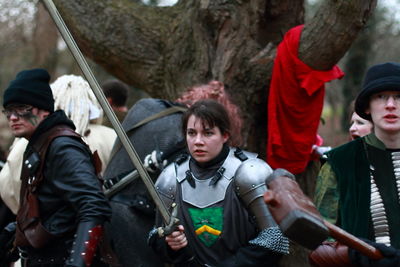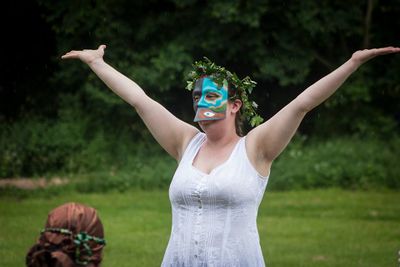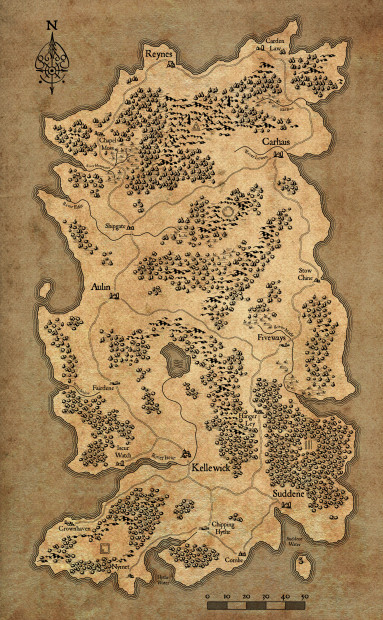Society History: Difference between revisions
From Cambridge Larp Society
m →Obscura |
|||
| Line 37: | Line 37: | ||
=== Obscura === | === Obscura === | ||
Next year's game is Obscura, a one year run fantasy game written by Jon Cooper. Centuries ago the world was a dark place, dominated by monstrous creatures and powerful magic, until a group of adventurers cut off the magical realm from the mortal by making the Sealing. Magic greatly faded and science grew to fill the gap. Now | Next year's game is Obscura, a one year run fantasy game written by Jon Cooper. Centuries ago the world was a dark place, dominated by monstrous creatures and powerful magic, until a group of adventurers cut off the magical realm from the mortal by making the Sealing. Magic greatly faded and science grew to fill the gap. Now the Sealing is starting to unravel, are the dark times destined to return, or can something be done to stop it? | ||
Revision as of 14:04, 23 May 2019
Cambridge University Treasure Trap
Treasure Trap was one of the first LARP games in the UK, it began at Peckforton Castle, Cheshire, in 1981. The success of the game led to the creation of various spin-off societies, including Labyrinthe, Durham Treasure Trap (DUTT), and the (now extinct) Birmingham Treasure Trap.

In 2002 Cambridge Treasure Trap was set up by two graduate students - Jennifer Curtis and Toni Badnall - who had enjoyed LARPing at DUTT during their undergraduate study at Durham and wanted to continue playing when they reached Cambridge.
The game of Cambridge Treasure Trap was in Grantabrugge, a loose analogue of medieval Cambridge. The game was inspired by fantasy media like Dungeons and Dragons, Dragonlance, and the Discworld Novels, but it also developed gradually through player action over its decade-long run. Players could play characters of various Races, such as elves, dwarves, or humans, and could be affiliated with city institutions, the colourful colleges of Magic, or any of the thirteen available religions.
Cambridge LARP Society
In 2014, the society decided to wrap up CUTT in favour of limited-run systems written by the active player base. At the same time the society's name was changed to Cambridge Larp Society to reflect that the game was no longer Treasure Trap.

No Flag No Country
CLS’s first game post-Treasure Trap was No Flag No Country (NFNC), a 2-year run pulp fantasy exploration and investigation game written by Ivan Slipper and James Blackshaw. NFNC ran between October 2014 and June 2016.
NFNC was set on the newly-discovered island of Mat Sellah. Each of the characters could be one of three races (standard Human, tattooed and pointy-eared Alfar, or scaly Ozgur) and hold a strong allegiance to one of the four churches, one of the three countries of the nearby continent, or one of two other investigative factions. The characters arrived on Mat Sellah to investigate and take advantage of the appearance of a magical Portal which surged with power from the Beyond, the place where both Gods and the demonic entities called Strangers lived. The game ended with the characters, having inadvertently used up most of the Portal’s power for their research, using its final gasp to allow The Explorer, one of the Gods, to manifest in the world.
More information about No Flag No Country can be found on its website.

Breaking Worlds
CLS’s third game was Breaking Worlds, a 2-year run apocalyptic fantasy game written by Nye Redman-White and Rosemary Warner. Breaking Worlds (BW) ran from October 2016 to May 2018.
BW was set in the island realm of Arginet, which until a year before the start of the game had been a stable and peaceful place. However, cracks had started appearing in the fabric of reality in a metaphysical outburst known simply as the Breaking, bringing with them strange people and dangerous creatures. In this tumultuous time, the characters of the game came together to explore, exploit, and defend against the tumultuous spirit world and the mysterious threat from beyond.
The game ended with the characters defeating the sinister other-world scientists who caused the disaster and uniting 5 diverse worlds to cooperate and restore the fabric of reality.
More information about Breaking Worlds can be found on its website.
Citadel
Our fourth game was The Citadel, a one year run post-apocalyptic science-fantasy game written by Robb Smith, Ivan Slipper and Pia Salter. Centuries after the Decline, an ancient citadel of advanced technology reopened, offering the local tribes of the Outlook an opportunity to learn the secrets within.
After learning of the Citadel's sinister past and purpose, and overcoming many challenges, the characters defeated the super-advanced AIs to gain dominion over the Citadel Core. After heated debate they chose to destroy it, so that the Citadel could never again be used to manipulate and dominate the Outlook.
More information about The Citadel can be found on its website.
Obscura
Next year's game is Obscura, a one year run fantasy game written by Jon Cooper. Centuries ago the world was a dark place, dominated by monstrous creatures and powerful magic, until a group of adventurers cut off the magical realm from the mortal by making the Sealing. Magic greatly faded and science grew to fill the gap. Now the Sealing is starting to unravel, are the dark times destined to return, or can something be done to stop it?